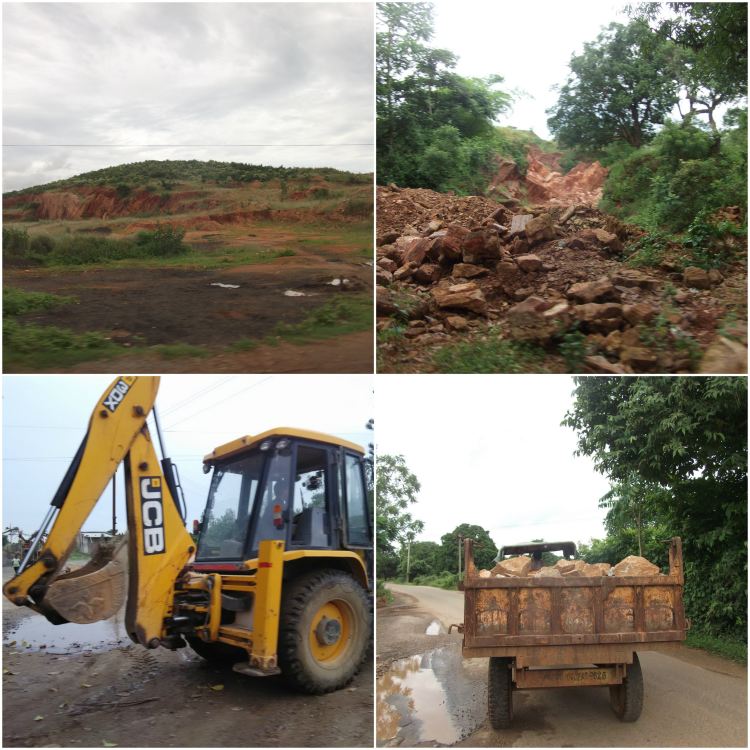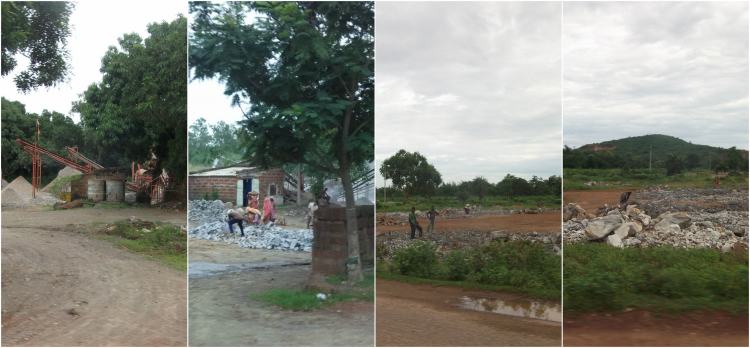You know you're in the village when roads have more potholes than paved paths, when men sit outside betel shops sharing a pan along with an antidote for life. It is where everyone stops whatever they are busy doing to look up the next passing bike on the road. Tucked away in the Khurda district of Odisha are an array of such villages filled with busy-slow lives.
A line of stone crushing units cover a large part of Khurda. The hills that used to dot the skyline have been cut down and hollowed to make gravel for construction. The nearby forest area is cut to mine the naturally occurring stones for the units. Every where I turn to look at the horizon, I see vast regions left naked in barrenness.
Large, powerful drills work on the stone bed to quarry slabs that are transported to the crushing units. And the workers in the crushing units use hammers and their own strength to break the slab into smaller pieces.
Till I visited Khurda, I never wondered where the stone chips used in the construction of roads came from. The hills that are now gone have become parts of roads and buildings in nearby towns, or even beyond. I learnt that the stones from these crushing industries is in high demand across the country. Infrastructure is an important part of a growing country's story. A large country like India needs enough to lay down its highways.
Inside these crushing units, workers work away pounding at piles of rocks, breaking it into gravel. Work hours are long and entire families from local villages work in the crushing units, toiling away, inhaling the stone dust to make Rs 150-200 for the day's work.
I visted Goda, a small village in Khurda to meet a group that had borrowed to buy a solar microgrid for their village. Since land owning is nearly impossible, stone crushing is a primary source of livelihood for most of the people in the group.

Pinki Parida, a member of the group, has been working at one of these units until she got pregnant. Her husband continues to work as a stone crusher. “We aspire to move towards agriculture and cultivation as a full-time business but the lack of land holds that dream difficult for my family," Pinki mentions. When sometimes not working at stone crushing unit, the family works in farms where they are paid a portion of the profits of the reap.
The Government provides legal sanctions for stone mining in the area but high demand has also lead to mushrooming of illegal stone quarries. The villagers themselves may be aware of the adverse effects of working in stone quarries are unable to separate themselves given the risk of unemployment. The Government ruling of shutting down units that operate within a distance of 500 meters from village clusters and 200 meters from highways has been a saving grace. But the reality of the workers within these units is far from better.
The stone crushing unit generates Airborne silica which has been for long suspected to be the cause of increased rates of silicosis, cancer, and other lung diseases. Children work without any protection or respirators end up being exposed to clouds of silica dust. Besides the possibility of silicosis there is a lifelong risk of being affected by TB.

There are various preventive solutions available besides the use of respirators. The simple method of application of fine mist of water is said to reduce respirable particulate. The relatively inexpensive water sprays available in the local market can be effective in reducing silica exposures. But until the owners involved in the business look beyond minting money, the lives of the labourers like Pinki and her husband are still at risk.








